Fishing Soft Plastics
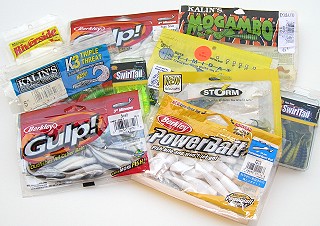 The evolution of soft plastic baits has greatly advanced over the years virtually giving anglers a wide variety and selection for all game fish.
The evolution of soft plastic baits has greatly advanced over the years virtually giving anglers a wide variety and selection for all game fish.
Soft plastics offer many advantages over hard bodied lures such as crank baits and spoons that does not have the soft texture as real food. When a fish strikes a soft plastic bait it feels natural so fish will mouth it longer giving the angler extra time to set the hook.
In making soft bait’s the plastic is heated into a liquid form then poured in a mold to replicate the shape, grub, worm, baitfish, crawfish, lizard, frogs, and insects.
During the bait making process additional ingredients can be added to appeal to the fish’s senses such as, scents, layered colors, metal flakes, and flavors. Other significant details of soft baits today in manufacturing is to add life like realistic features like crescent rings on worms and grubs, floating claws on crawfish, web feet and feelers on amphibians, holographic and translucent flash on shad and minnow baits replicating the scales of baitfish.
Other benefits in fishing with soft plastics are rigging the hook, the point can be buried into the body of the bait where it cannot snag underwater obstructions such as dense weeds, rocks, brush and logs, but yet the hook will penetrate through the soft bait when you set the hook. Another is scents, they can be treated with bottled-paste attractants or purchase them already molded in. Soft plastic’s will hold scents much longer than hard bodied lures that wash off quickly.
Fishing set-ups with Soft Plastics
In casting or vertical jigging the smallest soft plastic lures for panfish and crappies use ultra light spinning gear spooled with 4-6lb test monofilament. Species such as walleyes and smallmouth bass with a mid sized plastic’s use a medium light to medium spinning gear with 6-8lb test monofilament.
In using larger plastic’s with hooks buried into the bait that requires a strong hook set for large mouth bass and northern pike use medium to medium heavy bait casting gear spooled with 14 to 20lb test low stretch monofilament line. For muskies that have the largest plastic’s up to and over 1lb use heavy to extra heavy bait casting gear spooled with 50 to 80lb low stretch abrasion resistance braided line. Many rod manufactures specializes in making powerful fast action rods dedicated for soft plastic fishing.
The popular use by anglers of soft plastics has skyrocketed over the years by the increased number of new products introduced annually by lure companies this is evident with fishing tackle pro shops in store displays, catalog pages for online and print buyers guides.
As a reference listed below are a few of the most commonly used soft plastics in order to help you identify each type.
Worms

The invention of the plastic worm spawned more variations of soft plastic baits than any other in fishing lure history. Grubs, jerk worms, crawfish, tubes, lizards, swim/baitfish all where developed based on the introduction of the soft plastic worm technology back in 1949 by a Ohio luremaker. Worms come in sizes from a few inches for trout and panfish up to 12 inches for bass and pike.
The types ( floating and sinking) and the colors of worms made today are in hundreds of thousands with the multitude of color variations and scents. The main fish attracting action components of worms are the texture (ringed, ribbed or smooth) affecting the sink rate and the tail (ribbon, twister, paddle, or straight) which provides vibrations when the worm is moved. In rigging a worm, there are two options pre-rigged with a hook or series of hooks, or using a Texas rig the most common, Carolina rig, wacky rig and the drop shot rig.
Grubs

Fishing with soft plastic grubs has been a longtime favorite among anglers for all species. Grubs are composed of soft plastic round body either ringed, ribbed or smooth, combined with single curly tail, double curly split tail, paddle tail, or straight tails for various actions. Grubs come in various lengths from 1″ up to 12″ and hundreds of colors combinations.
The most common use for grubs is tipped on a jig, or as a trailer on a inline spinners and spinner baits. Grubs are also popular to fish using a drop shot rig, split shot rig and Carolina rigs.
Baitfish
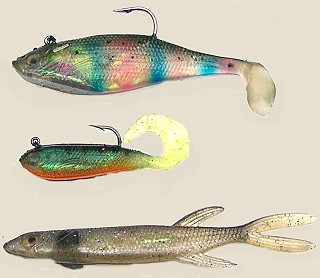
Soft plastic baitfish come in numerous sizes and colors to mimic forage fish. Determine what baitfish are in the waters you’re fishing and select a profile size and color to match, for a natural presentation. Usually the smaller the better.
Many soft plastic baitfish baits feature a paddle tail that wiggles when retrieved, but others have curly tails and forked tails that give them swimming action. Fishing soft plastic baitfish imitations are a excellent choice jigged along the bottom or brought in on a straight retrieve.
Tubes

Tubes are rounded hollow soft plastic bodied bait open ended with a series of tentacles on the base. The main body is usually smooth but some have a ribbed exterior. The interior hollow design works well with holding liquid or paste scents. Tubes range in sizes from 1″-2″ for crappies and panfish 3″-6″ for largemouth and smallmouth bass up to 14″ for big pike and muskies.
Most often tubes are rigged using a weighted tube jig placed within the tube’s body or to make a tube weedless anglers use a wide gap hook threading it through the nose and securing the hook into the body on the outer wall of the tube. Upon casting a tube it will display a spiral action on the fall with the tentacles undulating providing a injured baitfish look, in jigging the tube off the bottom it will appear as a crawfish imitation especially good for feeding smallmouth bass.
Tubes can be rigged as bait using a Texas Rig, Carolina Rig, or on a drop shot rig.
Crawfish

The soft plastic crawfish or crawdad is a deadly on bass when presented along rocky bottom area’s. The main feature of a imitation crawfish is the pinchers when tipped on a jig it gives the bait a realistic defensive posture by raising it’s claws that sends bass a signal to feed. Crawfish soft plastic’s are available from craw trailers to the highly detailed featuring pinchers, antennae, legs, abdomen and tail.
Lizards
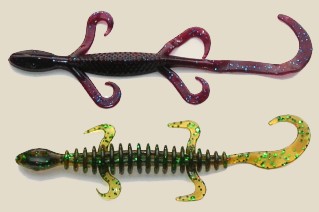
Fishing with a lizard in the early season especially during the bass spawn is particularly effective, as bass absolutely hate lizards. Various lizards have a reputation as bass bed robbers, they will raid a nest and eat the bass eggs even before the bass guardian has a chance to react.
Lizards come is a wide variety of colors, scents, ribbed, smooth, floating and sinking. The most common fishing techniques are similar to fishing plastic worms, using Texas and Carolina rigs or tipped on a jig for flipping and pitching.
Leeches & Reapers
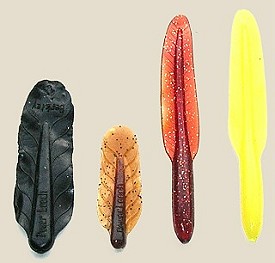
Leeches and reapers are a basic variation of a soft plastic grub, rounded head and body leading to a soft thin membrane sides. The smaller reapers resemble a leech while the larger reapers mimic baitfish. The sizes start from 3″ for walleye and bass up to 12″ for pike and muskies.
Most anglers rig a leech/reaper tipped on a jig head inserting the hook through the head or use a split shot rig and a single hook. Reapers are a good bait to use on waters that receive a high amount of angling pressure.
Frogs

Using a floating soft plastic frog around the lily pads for bass is exhilarating as the bass comes out of the water and engulfs your lure. The advantages of soft-plastic surface frogs are, they are weedless with the hooks positioned against the body, they feel natural with their soft spongy body, so the bass will hang on to the lure longer giving more time for the angler to set the hook. The best fishing tip we can offer while using a top water frog is fish slow.
After a cast let the frog sit until the ripples subside now pop or twitch the frog once or twice, then let the frog sit for a few seconds and repeat. To change up the presentation upon reaching weed pocket or opening let the frog sit and just barely twitch the frog so just the legs quiver. Summertime bass laying in the weeds aren’t active most of the time, but can be enticed by a easy meal.
Magnum
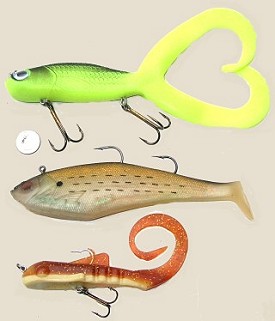
From the 1950’s through the 1970’s the soft plastic bait industry was focused on worms and grubs used for bass. That changed in the 1980’s when small basement lure companies started producing larger soft plastic lures designed for pike and muskies.
This spawned a revolution in the 1990’s regarding the soft plastic lure market as larger companies began taking notice and adding larger soft plastic baits to there product line.
Today there are hundreds of variations, colors, combinations of hard bodied soft tail baits, some even weighing 1 lb and 15 inches in length. Fishing with super sized soft plastic’s opened a new chapter and presentation for pike and muskies anglers through out the world.